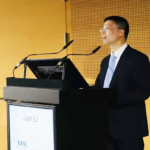At the 58th European Association for the Study of the Liver (EASL) Annual Meeting (EASL2023) and the 2023 EASL Congress, one of the highlights was the emergence of new antiviral therapies, especially for hepatitis B and hepatitis D. Several new drug studies were selected for oral presentations during the conference. Dr. George-Lau was invited to moderate the session on new therapies for hepatitis B and hepatitis D. Hepatology Digest had the privilege of interviewing Professor Ka-Chun Lao at the conference to discuss the progress in hepatitis B and hepatitis D new therapies and his insightful views on functional cure for hepatitis B.
Hepatology Digest: Can you talk about the research developments at this conference that you find particularly noteworthy?
Dr. George-Lau: There are many small molecule drugs under investigation for hepatitis B, such as anti-sense oligonucleotides (AON) and small interfering RNA (siRNA). However, the data shows that none of these drugs have achieved the primary therapeutic targets in Phase I or Phase II studies. Using small molecule drugs alone, most patients experience viral rebound after discontinuation, and the original intent of achieving functional cure cannot be realized. There are no exciting results from other research areas at the moment.
One major highlight of this EASL Congress is a study on the immunology of chronic hepatitis B conducted by the University Hospital of the Technical University of Munich in Germany [1]. This study explores the status of HBV-specific CD8 cells in the liver, further identifying molecular markers for T cells that affect the rheostat of liver tissue. This allows for the exploration of new targeted immunotherapies to restore virus-specific immunity in chronic hepatitis B.
I believe this direction is crucial because hepatitis B is the result of the interaction between the virus and the immune system. Many studies have shown that simply targeting the virus lifecycle cannot achieve functional cure. Still, very few have focused on how the interaction between HBV’s lifecycle affects the immune system. In my opinion, to make progress in the field, especially in clinical science, we must first understand the immune system’s response. Only then, in combination with the use of small molecule drugs, can we possibly achieve functional cure.
Hepatology Digest: Overall, how do you assess the current status and prospects of research and development of new drugs or strategies for curing hepatitis B and hepatitis D?
Dr. George-Lau: Hepatitis D research is exciting. In general, there are drugs available for hepatitis D that can block HDV from entering cells, and HDV RNA can remain negative. This is very important. Hepatitis D is less prevalent among the Chinese population but is mainly found in South American Amazon regions, Mongolia, the Golden Triangle, and other areas. However, patients with both hepatitis B and hepatitis D have a significantly increased risk of liver inflammation and sequelae, so curing hepatitis D in patients with hepatitis B is also a positive development.
As for hepatitis B, what should we do now? From a clinical perspective in hepatology, the main issue is not the virus itself, but the sequelae it causes, including hepatocellular carcinoma (HCC), end-stage liver cirrhosis, and acute liver failure. We already have nucleos(t)ide analogs and interferon-based drugs for hepatitis B. Interferon treatment for 48 weeks can achieve a 3% to 5% rate of hepatitis B surface antigen (HBsAg) seroconversion. Even if seroconversion is not achieved, the use of potent and safe nucleos(t)ide analogs for long-term treatment can significantly suppress viral replication, reducing the occurrence of liver cirrhosis, related complications, and HCC.
Regarding functional cure, I support scientific development, but functional cure is currently almost impossible to achieve. Based on all the research data available so far, I don’t see how it can be achieved at the moment. Why is it so challenging? Because the pathogenesis of hepatitis B is relatively complex, it requires the involvement of the immune response. We have not fully understood the relationship between hepatitis B and the host mechanism. All Phase II clinical studies on functional cure have failed. Even if there were “mild” successes, a closer examination of the data revealed many issues, especially viral rebound after treatment discontinuation.
Take hepatitis C treatment as an example. Hepatitis C does not have covalently closed circular DNA (cccDNA) and integrated DNA within liver cells, so there is no viral rebound after discontinuation unless reinfected. Unlike hepatitis C, hepatitis B has both cccDNA and integrated HBV DNA, so after HBsAg seroconversion, there can still be relapses, especially when immunosuppressive agents used in other medical fields can cause relapse after HBsAg seroconversion. Even with the use of small molecule drugs, it is impossible to completely eliminate cccDNA and integrated HBV DNA, leading to an immediate rebound after discontinuation. Currently, all investigational small molecule drugs are used in combination with interferon to improve the immune system’s function and then utilize the immune system to control hepatitis B and achieve HBsAg seroconversion.
Hepatology Digest: As you mentioned, functional cure for hepatitis B may not be very meaningful. Should we consider a different direction now?
Dr. George-Lau: Personally, I believe pursuing functional cure may not be very meaningful. Currently, nucleos(t)ide analogs and interferon drugs are highly accessible, and their prices have significantly reduced compared to the past. Patients can adhere to these treatments, and stopping the treatment may lead to a relapse. Therefore, our focus should be on understanding the mechanisms and using treatments to restore the immune system, rather than solely suppressing viral replication. So, I think the research by the German scientists mentioned earlier is quite important because it focuses on the specificity of HBV-specific CD8 cells in the liver. We need to understand how drugs affect the immune system from this perspective, allowing patients’ immune systems to be reestablished, which may lead to genuine recovery. But again, even after HBsAg seroconversion, there can still be relapses. So, what is the significance of pursuing functional cure? This is a question worth considering.
Perhaps we should invest more resources in other aspects of liver disease, as suggested by academician Hui Zhuang and other Chinese experts at the conference. We should expand the treatment base, identify individuals with HBsAg seroconversion, treat them early, and suppress HBV DNA. This is what the field of hepatology should do for patients.
Hepatology Digest: Can you talk about other topics or research that you find interesting at this EASL conference?
Dr. George-Lau: Chinese experts have made impressive achievements. Professor Rong Fan’s team at Nanfang Hospital of Southern Medical University conducted a study on a novel high-precision HCC prediction model aimed at developing and validating new prediction models using longitudinal data and cell-free DNA (cfDNA) by merging or not merging multiple longitudinal data, [2].
The study developed and externally validated two new and more accurate HCC prediction models: aMAP-2 and aMAP-2 Plus scores.
The aMAP-2 score is calculated using longitudinal data on aMAP score, AFP, and ALT over up to 8 years of follow-up and demonstrated excellent performance in the Search-B training (n=3706, AUC=0.84) and external validation (n=5796, AUC=0.85) CHB cohorts.
The aMAP-2 and aMAP-2 Plus scores are models that predict HCC more accurately in patients with or without liver cirrhosis and can effectively guide personalized monitoring of HCC nationwide. This is an original Chinese technology that significantly improves predictive efficacy and is a very promising technological foundation, which excites me greatly.
References
[1] Bosch M et al. A PKA-associated liver-tissue rheostat curbs T cell receptor signalling and effector function of virus-specific CD8 T cells in chronic viral hepatitis. Oral presentation(OS-032). EASL Congress 2023.
[2] Fan R et al. Novel, high accuracy prediction models of hepatocellular carcinoma based on longitudinal data and cell-free DNA signatures. Oral presentation(OS-033). EASL Congress 2023.
TAG: EASL2023;Interview;HBV;HDV


